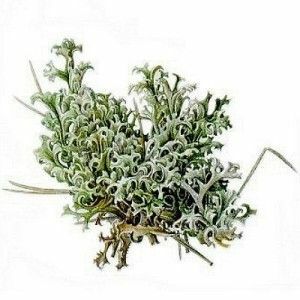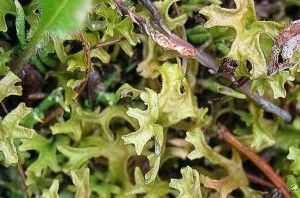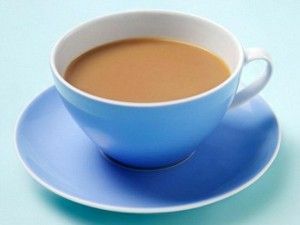Contents:
- Morphology and physiology of the plant
- Healing properties
- Traditional medicine
 Icelandic moss belongs to the lower plants. His body - a thallus - does not have vegetative organs and almost does not look like leafy plants.
Icelandic moss belongs to the lower plants. His body - a thallus - does not have vegetative organs and almost does not look like leafy plants.
The name Icelandic cetrarium is of Latin origin, it comes from the word cetra, which means a leather round shield of Roman soldiers. This name was given to the plant due to the form of the organs of sporulation - apothecia.
Species definition indicates that for the first time people have learned about the medicinal properties of plants from Icelanders.
Morphology and physiology of the plant
The thallus or thallus of cetraria has a bushy structure whitish, greenish or brown, consisting of flat or tubular blades up to ten centimeters in height and up to four centimeters in width. Icelandic moss in the lower part is covered with red spots, and the edges of its blades have cilia. When treating the thallus with a 10% solution of potassium hydroxide, it turns yellow.
Important! Mosses and lichens do not have roots, they are replaced by outgrowths of skin cells - rhizoids.
Cetrarium, like any other lichen, is a product of symbiosis. Icelandic moss combines two organisms with absolutely opposite properties: green algae synthesizing organic substances in the process of photosynthesis, and a fungus that feeds on these substances and supplies the alga with water with dissolved mineral salts, which it absorbs from the external environment. Lichens reproduce by spores that germinate, intertwine with filaments and form rudimentary thallus. It forms a real lichen only after contact with a certain species of algae. Probably and asexual reproduction with the help of groups of cells containing filamentous fungus and alga cells. Tetraria grows mainly on sandy soils in light pine forests, on swamps among mosses. This is the most common lichen, which is the main food for reindeer.
Healing properties
Icelandic moss is used by official pharmacology in food additives - dietary supplements and in the form of phytospores with sage, chamomile, thyme, elderberry, calendula. The healing properties of Icelandic moss and its widespread use in folk medicine are explained by its unique composition.
- The cetrarium contains about seventy percent of mucous substances consisting of lichen polysaccharides and isolhenin, a lichen starch. They are extracted with hot water, and then cooled to form a gelatinous mass.
- Lichen acids have pronounced antibacterial properties.
- The plant also contains bitter, proteinaceous substances, fats, wax, gum, enzymes, pigments and the like.
- This species is characterized by the accumulation of large amounts of zinc, tin, cadmium, lead and silicon.
Traditional medicine
Medical value

In ancient times, mountain people used Icelandic moss in the form of thick jelly with honey and survived in hungry time with the help of sheep's milk and boiled moss in it. This not only improves digestion, but also cleanses blood, lymph, and has an anti-inflammatory effect. Inhabitants of the extreme north for the rapid healing of even torn and infected wounds used hot poultices from cetraria. Icelandic moss for children served instead of diapers, and Eskimos treated the breast with appliqués from a steamed lichen. Cetrarium contains mucous substances, due to which it has a pronounced enveloping action. With diarrhea, intestinal atony, gastritis, stomach ulcer, colitis, chronic constipation, recommend a decoction prepared from twenty grams of moss and a glass of boiled water. Take such a decoction of three tablespoons daily.
Important! Pre-washed from the bitter taste of the decoction is a food antidiabetic remedy.
Icelandic moss preparations have a curative effect:
- antimicrobial,
- anti-inflammatory,
- laxative,
- wound healing,
- choleretic.
Thick mucus decoction is used not only to treat pathologies of the digestive system, but also for pulmonary tuberculosis, pneumonia, whooping cough, bronchial asthma, chronic bronchitis and food allergies.
Warning! Lotions and washings with such decoction are used to treat purulent wounds, pustular rash, burns, boils, chronic dermatoses, neurodermatitis.
Recipes

- The traditional recipe for preparing broth from moss is the following: take 500 milliliters of boiling water or hot milk and one tablespoon of crushed dry lichen, mix, boil in a water bath for five minutes, and then insist for thirty minutes andfilter. So prepare a decoction for ingestion. For outdoor use it is prepared exclusively on water.
- Extract from moss is obtained in this way: pour a liter of cold water, one hundred grams of crushed cetrarium, insist for 24 hours, filter, put on a water bath and evaporate at half of the original volume. Take three times a day for half an hour before meals. Moss extract is used as a laxative. Duration of treatment - two weeks.
- Icelandic tea is used for catarrhal diseases, bronchitis, pneumonia. This tool has been recognized by many peoples of Europe, in particular among the Yugoslav peasants. Brew it like this: put a teaspoon of lichen in a cup of steep boiling water, insist and drink like regular tea once a day, preferably before going to bed.
The duration of treatment with such tea varies depending on the circumstances and the state of health of the patient in each particular case and ranges from one to three months. - Collection, consisting of Icelandic moss, flax grass, lemon balm leaf and the salepa tuber, is recommended for impotence. Pour a tablespoon of herbs with a glass of boiling water, insist, wrapped, a couple of hours, filter and drink three cups a day.
- With pneumonia or severe form of bronchitis, take a decoction prepared according to such a recipe: put a spoonful of crushed moss in a glass of milk, cover a container with a nonmetallic plate or saucer and simmer for thirty minutes. Take a hot broth daily before bedtime. When pneumonia takes a crushed lichen, mix it with pine buds and the root of a fragrant violet. Then pour this mixture with a glass of cold water, insist for two hours, boil for five minutes and take a warm infusion.
- Tuberculosis of lungs is treated with decoction of cetraria. Brew a glass of boiling water twenty grams of Icelandic moss, warm on low heat for ten minutes and drink a whole glass six times a day.
Icelandic moss has no contraindications and side effects, so it can be taken quite a long time - for years, both adults and children.
